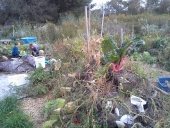Here is the previous thread. As I have not seen a lot of other information on it, I'm not sure if it is in the area of speculation or well documented research. It's an interesting idea though:
"How to Activate Charcoal
Activated Charcoal (also called Activated Carbon) is made by EITHER heating charcoal in temperatures exceeding 600 degrees C (1,100 degrees F) while in a no-oxygen environment (This requires using a special chamber where you can heat up your charcoal in the presence of something like Argon instead of a regular mix of air to prevent any oxidation), OR crushing normal charcoal to a powder, adding an strong acid, strong base, or salt, then heating it again to temps between 250-600 C (400 - 1,100 F) <-- much more accessible!
Recipe for activating charcoal:
> Pickle Crisp - Calcium Chloride - a type of salt. You can buy it in big tubs at most places that sell pickling materials.
> Water
> Charcoal
Step 1: Make charcoal. Then powder charcoal by smashing with a hammer or using mortar and pestle.
Step 2: Be careful, this step generates heat. In a STAINLESS STEEL (not aluminum) bowl; Make a 25% solution of calcium chloride with water, at a 1:3 ratio.
If you have 600 ml of water you want 200 grams of calcium chloride. You want to make enough of the solution to completely cover the powdered charcoal.
Using tapwater is fine, because the amount of trace minerals in tapwater is basically nothing compared to how much the carbon can adsorb.
Step 3: Add your solution to your powdered carbon, a little bit at a time. You may not use all of your solution - once it reaches a thick paste consistency (like peanut butter), stop adding more solution and just mix the paste until smooth. Get out all the lumps.
Step 4: Cover the bowl with a towel and let it sit untouched for 24 hours to allow the chemical reaction to continue.
Step 5: Drain off the liquid using a coffee filter or very fine muslin cloth. Put the sludge back into your metal pot.
Step 6: Take your pot of nearly-activated-carbon, put the lid back on, and put it into a fire that exceeds 200 degrees C (400 degrees F) - a normal campfire should do the trick. Keep it on the fire with the lid on until it stops steaming, and then take it off to let it cool - don't open the lid until it's completely cool.
Congrats, you’ve activated your charcoal!
WARNING:
When ingested, Charcoal and Activated Charcoal will ALSO bind to medicines in your gut, along with helpful vitamins, minerals, and antioxidants from our food instead of letting the body absorb it. Our bowels pass the charcoal much faster than the charcoal takes to release those nutrients and medicines back to us.
DO NOT ingest activated charcoal within 48 hours of taking, or expecting to take, any type of necessary medicine. Especially antidepressants and anti-inflammatory medications. The charcoal will likely deactivate & adsorb it - or at the very least make it less effective than that dose should be.
Charcoal and Activated Charcoal is not absorbed by the bloodstream. It stays in the digestive tract until excreted via bowel movement. This means it has no ability to remove alcohol from the bloodstream."
Here's the link to the whole thread, which is pretty long, but has a lot of information:
https://permies.com/t/193954/handy-guide-charcoal-biochar-activated
I have never used the calcium chloride version, and as I seem to recall, he mentioned that on my small scale, it might not be worth it.
John S
PDX OR

 4
4




 6
6




 4
4












 1
1




 1
1




 1
1












